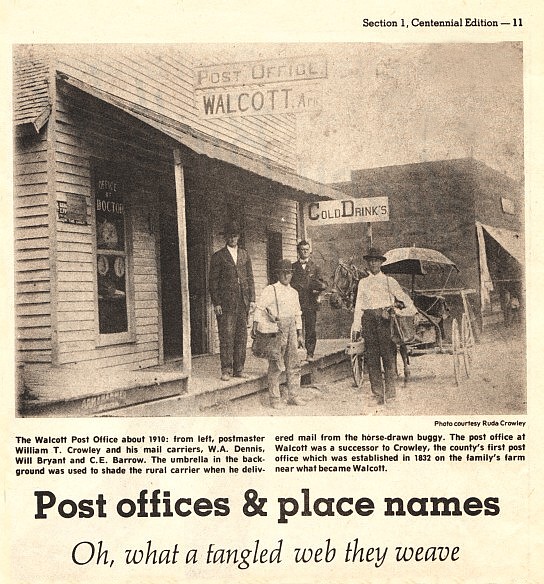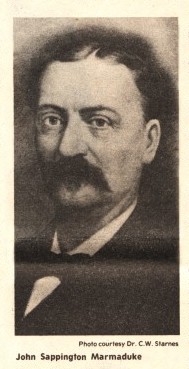
Greene County Arkansas
Paragould, Arkansas
Centennial Edition Section 1
Paragould Daily Press, Monday, August 29, 1983 Section 1, Centennial Edition --11
=============================================================================================================

| The Walcott Post Office about 1910: from left, postmaster William T. Crowley and his mail carriers, W. A. Dennis, Will Bryant and C. E. Barrow. The umbrella in the background was used to shade the rural carrier when he delivered mail from the horse-drawn buggy. The post office at Walcott was a successor to Crowley, the county's first post office which was established in 1832 on the family's farm near what became Walcott. |
| The first post office in
what is now Greene County was established on Nov. 29, 1832--almost a
year be-fore the county was cre-ated--when Benjamin Crowley was
appointed postmaster of what was named, naturally enough, the
Crowley post office, seeing how it was located in his home. Early postmasters often lent their names to the new postal addresses.But that's the easy part. Trying to de- cipher other place names is like trying to read hierogly-phics without the Rosetta Stone. For instance, less than 15 years after it was established, the name of the Crowley post office was changed to Walcott and no one has ever been able to prove why. A short article in a 1965 Greene County Historical Quarterly cites two poss- ible explanations, one story saying that a man named Walcott succeeded Crow-ley as postmaster and moved the post office into his store at the small town that grew up near the Crowley farm. But postmaster rosters compil-ed by Dr. C. W. Starnes from the official postal sources of the National Archives and Re-cords Department in Washington, D.C., do not list a Mr. Walcott. The other story cited by the quarterly article is far more fun. "There is a leg- end," the writer noted, "concerning a man named Walls who lived on the hill above the store, in a little cabin. He was fond of spending his time resting on a cot which he placed un- der the trees near his cabin. People passing began calling the place Wall's Cot, from which the name gradually became the Walcott we know today. "While the story sounds far fetched," the article continued, "it is frequently repeated and no one has come forth with another." No matter the reason, resi-dents of Walcott are doub- tless glad that name stuck, for the quarterly article went on to note that the place was first called Fleatown because great clouds of fleas bothered the farm animals in the vicinity. After the Civil War, the Walcott post office under-went a see-saw experience that had been and would be shared by other post offices at other times. It was dis- continued in 1867, re-esta-blished in 1870, only to be discontinued again in 1871, re-establish-ed in 1874, discontinued in 1875 and re-established again in 1881, remaining established this time for 102 years and counting. Despite the name change, the Crowley family main-tained its link with the Wal- cott post office. Benjamin H. Crowley was post-master from 1882 to 1890 and William T. Crowley was postmaster from 1908 to 1917. Interestingly, another post office named Crowley was established, near Walcott, in 1856--10 years after the name of the first Crowley post office had been chan-ged. There are no Crow- leys listed as postmaster of this office yet, perhaps just as interestingly, a Wesley Wall was postmaster from 1858 to 1860. It is not known whether he rested on a cot. But when this se- cond Crowley post office was discontinued in 1906, the mail was sent to Wal-cott. Because the original Greene County included a much larger area than it does now, some of the sites of the early post are now located in other counties. These include the county's second post office, estab- |
 lished on
Nov. 11, 1833, only days after Greene County was created. Called County
Line, it was probably located near what was then the Greene-Jackson
county line. In 1842, its name was changed to Farm Hill and it was
relocated in Poinsett County, which had been carved from Jackson County
in 1838. The site is now probably in Craighead County. |
A small cemetery five miles east of
Rector is said to contain the graves of about 30 of these raiders. Marmaduke, a Missouri native, became governor of that state in 1885 and died in office in 1887. Interestingly, from the standpoint of Marmaduke being a railroad town, its namesake was Missouri's railway commissioner from 1875 to 1880, another fact that may have influenced Paramore's railroad to name the town for him. In 1890, a post office was established at Loulyma. It was named for the three daughters of postmaster Carl Gilg--Louise, Lily and Mary. But the name created a bit of a problem. You see, railroad freight coming to the same place was addressed to Newberry, since that was the name of the local rail-road station--it having been named for W. C.Newberry, a local saw-mill operator. This awkward situation persisted for 12 years, until postmaster Lafayette "Lafe" Mueller offered his nick- name as a compromise. The U.S. Post Office Depart-ment, which had reportedly created the problem by rejecting the Newberry name when it was first proposed, accepted the new name in 1902. When it was established in 1894, the Beech Grove post office was simply known as Beech. The official name was not changed until 1901, shortly after it was re-established, having been discontinued in 1895. Like many other places in Greene County, Beech Grove took its name from nature. The first sett-lers were said to have struck camp in a grove of beech trees. Stonewall got a post office in 1884, lost it in '85, re-gained it in '86, lost it again in '87, regained it in '88. It is said to have taken its name from, you guessed it, a man named Stonewall who did now own a cot. No, just kidding. Really, the place should have been called Stonewalls since large stone walls had been erected on both sides of the Cache River to keep water off the railroad. The first postmaster, J. A. Collins, had wanted the place to be called Collins-ville, but that name was re- jected by the Post Office Department with the ex- planation, "There is already an office named Collins and one named Collins Bluff in the state." The post office didn't want to take any chances. Other Greene County post offices and the dates of their existence include Oak Bluff 1844-68; Lorado 1848-1913; Newport 1852-59; Poplar Creek 1854-58; Shakespear 1855-69; Campabello 1856-66; Loyal HIll 1869-72; Griffin 1870-76; Mackville 1875-78; Clarksburgh June 1876-December 1876; Finch 1878-1906; Knobville 1878, changed to Tillman-ville 1880, which was dis-continued 1893; Bethel 1880-1914; Cache 1881-82; Halliday 1886-1923; Amberg 1889-90; Bard 1890-1912; Daisy 1891-92; Bertig 1894-1914; Mack 1895-1906; Rice 1895-1906; Bailey 1895- 1903; Light 1900-67; Stanford 1901-06;Brighton 1901-21; Iris 1903-08; Blackjack 1903-14; Goff 1908-09; Talley 1911- 30; and Walnut Corner 1919-29 (but it was called Smerney 1923-26.) Some sites of the earlier post offices may now be located outside of the pre- sent Greene County. And many of the post offices listed here were discon- tinued and re-established several times. |
The next page (11a)contains names of city employee's from this portion,
I thought would be interesting for the researcher.
Transcribed from the 1983 Centennial Edition by : PR Massey
Return to Greene County, Arkansas Centennial Edition
Return to Greene County, Arkansas Newspapers
Return to Greene County, Arkansas Index Page
© 2011PR Massey